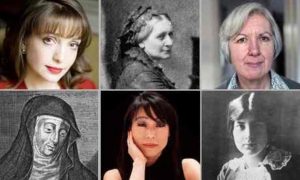
Top Row (L-R): Roxanna Panufnik, Clara Schumann, Judith Weir.
Bottom Row (L-R): Hildegard of Bingen, Unsuk Chin, Lili Boulanger. Credit: Keith Saunders, Getty Images, Eamonn McCabe, Eric Richmond/ArenaPal, Library of Congress.
Imagine this. You have walked into your morning registration class and, as always, your form tutor has left everyone a challenge to do. The challenge today is to write down all the women composers you know of. It makes you think for a minute before writing. The word “composer” has stopped you. There are of lots of female artists within the music industry today and many who write their own music. You start writing down names and after two minutes of writing your list contains the likes of Adele, Beyonce, Lady Gaga, Rhianna, Katy Perry, Ellie Goulding, Meghan Trainor, Miley Cyrus, and of course Taylor Swift. All these girls write their own music, and therefore, compose music. The lists shared afterwards are full of similar names and all are contemporary singer-songwriters. You think nothing of this until you enter the classroom the next morning. The challenge displayed today asks everyone to write down all the women composers you know of within classical and jazz genres only. This makes each and every student pause to think. Are there any women composers in those genres? You think for ages and sift through different types of music within those genres: symphonic, chamber, vocal, choral, operatic, traditional jazz, contemporary, film and television music but your mind remains truly blank. Finally, you give up, and your classmates follow suit as pens hit the desks in frustration. It would turn out that not one person could think of a name and this is the problem female composers past and present face.
Those studying musicology will know that women within the music world have been largely forgotten. This was particularly so in the past and is still so in some genres today. When looking through the masses of books available online, it soon became clear that books on female composers are rare. Those available were published in the 1980s and 1990s. In the years since then, just one major book on women composers has hit the seller lists, and that was earlier this year. Then I found the statistics from a BBC Proms survey by Women in Music that highlights the numbers of women represented in the concert season since 1989. Figures vary. From 1989 – 2005, the numbers of women composers featured in concerts ranged from between one to five. The figures for women conductors, meanwhile, hover between one and three. The 2006 BBC Proms season saw a total of zero women composers and conductors featured in concerts alongside just 9/45 female instrumental soloists. In 2008, the figures were unusually high with 10/145 composers represented. With statistics like these, it is not surprising that people around the world cry out in exasperation and shout, where are all the female composers?
There are so many female composers out there, and yet, their names remain unknown. Women have actually been composing music for hundreds of years. If we delve deeper into the history books, we will find that nuns wrote music for their own use, with the most famous being Hildegard of Bingen (1100s). When moving along the timeline we discover upper-class women singing and playing music in grand homes for private viewings. Some women took this further and started composing music of their own. The advent of the creative woman caused a huge stir within society. These women lived in times where cultures of belief made life for a woman all the more harder. The Old Testament, for instance, had spread the theory that listening to a female voice in song was sexual enticement. It didn’t help that society in general was heavily male-dominated. Those women taking on these challenges to write music and express themselves through music were considered abnormal by society. It was most certainly not the proper way for an upper-class woman to behave. The composer profession for women, therefore, was thought of as lowly by society. As a result, the talent displayed by many women went unrecognised until the more recent gender studies craze brought the history of women to light much of which had been forgotten. The recent interest in this element of history has meant that those forgotten stories have now been uncovered. For instance, some women spent their entire lives in the shadow of famous brothers or husbands, and this trend would continue well into the jazz era.
All is not doom and gloom though. We are now finding new ways to tell the stories of creative women all around the world. The internet has seen a growing abundance of information about women composers in recent years as recognition of what these women have contributed to the world of music grows. This column aims to tell the stories of great women composers. Some of these women worked against traditional social values to finally beat the odds and succeed. Others, meanwhile, faced a continuous struggle to be recognised. The stories highlight the achievements of these amazing women many of whom have been forgotten.
Further Reading for the interested!
To read more on women composers, a recommended book would be Sounds and Sweet Airs: the Forgotten Women of Classical Music, by Anna Beer (2016). It provides an easy-to-read introduction and further reading for anyone who might be interested.
The internet is useful to explore the topic further and check out recordings or interviews with contemporary composers from the past 100 years or so. The following sites have proved useful when writing the posts for this column:
https://www.theguardian.com/music/2011/mar/13/london-oriana-choir-women-composers
http://www.bbc.co.uk/blogs/aboutthebbc/entries/40a1f40e-76b8-406c-9bdd-ecacdba7053f
http://www.bbc.co.uk/programmes/p02kn2t6
The Maud Powell Society have also created the Signature: Women in Music magazine that is available online and is a wealth of information.
-Claire Amundson
Junior Girl
Girl Museum Inc.
